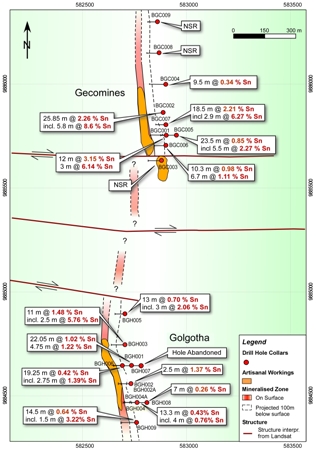Alphamin Resources Corp ("Alphamin" or the "Company") is pleased to announce that the next phase of diamond drilling has commenced on the Gecomines target area of the Bisie Prospect, North Kivu Province, east central Democratic Republic of Congo (DRC).
 Location of drill holes with main tin intervals and inferred mineralisation
Location of drill holes with main tin intervals and inferred mineralisation
Initially one drill rig will test mineralisation over a strike length of 275m down to a vertical depth of 200m. A second rig is expected on site during the second Quarter. An infill drilling programme of 23 drill holes for 3000m has been designed to follow up on excellent tin results reported from the Gecomines target area which was the focus of artisanal mining in the past. It is reported that artisanals mined a high grade chute of 15-20m x 8m with reported grades of >50% SnO2 (cassiterite). To date the chute was not intersected from drilling although significant grades of 3m @ 6.14% Sn, 11m @ 4.75% Sn and 2.9m @ 6.27% Sn were reported.
The programme will enable the Company to release its first maiden resource estimate at Gecomines.
Background
The Bisie project is located in the Walikale district of North Kivu Province, DRC and is held by Alphamin's 100% owned Mining and Processing Congo sprl (MPC). MPC holds a total of five tenements covering an area of 1,470sqkm with significant tin, gold and base metal potential. The key prospects within the Bisie Project are the Bisie Tin Prospect mined previously by artisanal means and the Omate gold workings exploited historically by the Belgians and currently mined extensively by artisanals.
The Bisie Prospect was the DRC's largest producer of tin ore for a number of years and accounted for up to 75% of the DRC's tin output.
Alphamin lifted force majeure on PR5266 which hosts the Bisie Prospect in February 2012 and commenced diamond drilling during the second half of 2012 at two target areas, Gecomines and Golgotha, mined extensively by artisanal miners. Significant high grade tin mineralisation was reported from drilling at both target areas. The tin mineralisation is also closely associated with copper and light rare earth (cerium and lanthanum) mineralisation as well massive and disseminated lead and zinc sulphides and significant amounts of silver.
Although tin does not respond to geochemical soil sampling due to its immobility, results from recent soil sampling programmes have highlighted lead and zinc in soils for a further 2km to the south of the Golgotha workings suggesting tin mineralisation can be expected for at least 2km to the south of Golgotha. The lead and zinc in soil anomaly has been defined over a minimum of 4km along the Bisie ridge and remains open to the south where the soil sampling has not been completed.
High grade mineralisation at Bisie appears to be controlled by a series of crosscutting northeast or east-west trending faults identified along the ridge from landsat imagery. The Company is therefore highly confident of discovering new high grade zones of tin and base metal mineralisation from systematic exploration along the ridge.
Mineralisation at Bisie is from surface on a ridge which lies at least 200m above the surrounding countryside and therefore highly amenable to open cut mining. This mineralisation is open at depths below 150m.
Lars Pearl, a qualified person under National Instrument 43-101, has verified technical data disclosed in this release.